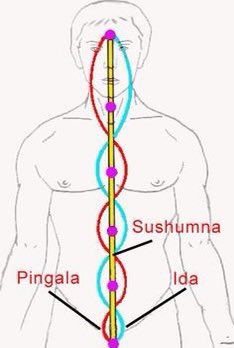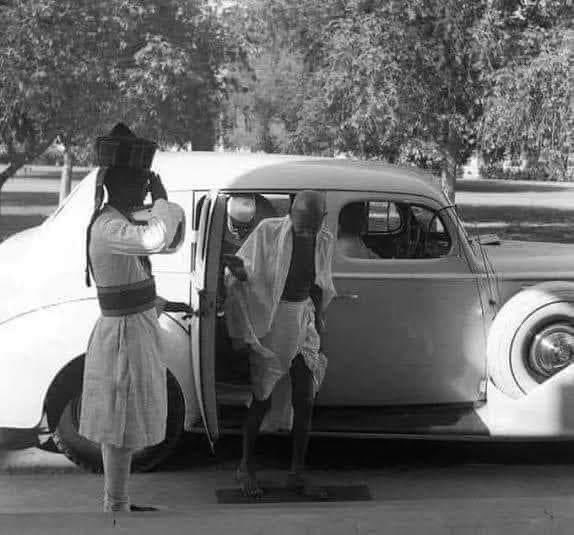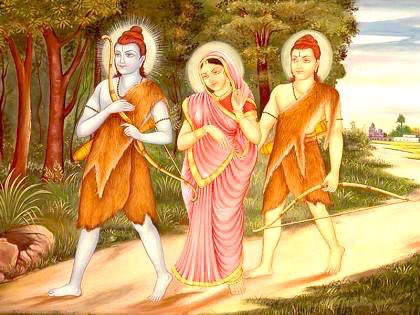
The Energy Channels or Nadis
(Ida,Pingala & Sushumna)
The word ‘Nadi’ comes from the root ‘Nad’ in Sanskrit means ‘hollow stalk’.It refers to the network of channels through which the energies such as prana of the physical body,the subtle body & the causal body are said to flow.
(Ida,Pingala & Sushumna)
The word ‘Nadi’ comes from the root ‘Nad’ in Sanskrit means ‘hollow stalk’.It refers to the network of channels through which the energies such as prana of the physical body,the subtle body & the causal body are said to flow.

Kundalini travels throughout our body by way of these three energy channels, or nadis. All three work perfectly together to integrate and balance the flow of our Kundalini.
Each also plays a specific role in maintaining our emotions, moods and physical health.
Each also plays a specific role in maintaining our emotions, moods and physical health.
The three principal nadis that run from the base of the spine to the head are the ‘Ida’ on the Left, the ‘Sushumna’ on the Centre, and the ‘Pingala’ on the Right. Ultimately the goal is to unblock these nadis to bring liberation.
(1) Ida Nadi – Called the left channel, Ida is a Sanskrit word which means “comfort”. it starts in the Muladhara (root) chakra, flowing to the left and weaving in and out of the chakras before ending in the left nostril. This Nadi represents mental energy. 

Ida Nadi is feminine energy with a cooling effect. It is introverted and is associated with the right side of the brain and the left side of the body. It is also called “Chandra” or “moon” Nadi since it is associated with lunar energy.Ida Nadi controls all of the mental processes
It carries pranic energy and nourishes and purifies the body and the mind.
It is characterized by calm, peace, stillness and being composed. It is associated with the right hemisphere of the brain (creativity, emotions, artistic abilities).
It is characterized by calm, peace, stillness and being composed. It is associated with the right hemisphere of the brain (creativity, emotions, artistic abilities).
When the Ida Nadi is blocked, one experiences cold, depression, low mental energy and sluggish digestion.
Physically, the blockage could simply be a blocked left nostril, restricting airflow and there by restricting prana flow.
Physically, the blockage could simply be a blocked left nostril, restricting airflow and there by restricting prana flow.
(2) Pingala nadi – located on the right side of the body Pingala Nadi also starts in the root chakra, but flows to the right, weaving in and out of the chakras in a mirror image of Ida Nadi and ending in the right nostril. Pingala nadi is the origin of prana.
Pingala Nadi is masculine energy and has heating temperature, adding vitality, physical strength and efficiency. It governs the right side of the body and the left side of the brain. It is also called “surya” or “sun” nadi since it is related to solar energy.
It controls all of the vital
processes. Pingala is
extroverted.
When the pingala nadi is
blocked, one experiences heat,
quick temper and irritation, itchy
body, dry skin, dry throat,
excessive appetite, and this
could all be caused by a physical
blocked right nostril.
processes. Pingala is
extroverted.
When the pingala nadi is
blocked, one experiences heat,
quick temper and irritation, itchy
body, dry skin, dry throat,
excessive appetite, and this
could all be caused by a physical
blocked right nostril.
3) Sushumna Nadi - is considered to be the single most important energy channel within the body. This central channel runs from the base of the spine up to the crown of the head – along the central axis of the core.
It is believed that there is a sacred, coiled serpent energy that lives in each and every one of us. Typically, this energy (known as Kundalini Shakti) lies dormant at the base of the spine, coiled three and a half times around the Muladhara Chakra (Root Chakra).
Once awakened, Kundalini Shakti rises up the central channel of Sushumna, activating every chakra in its path, to reach its true home at the Sahasrara Chakra (Crown Chakra). When this happens, we reach enlightenment.
• • •
Missing some Tweet in this thread? You can try to
force a refresh











